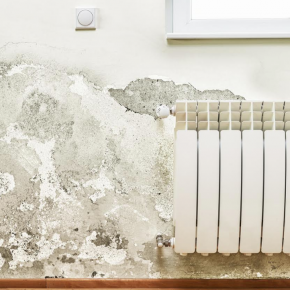
Safeguard welcomes new law to ensure rented homes are habitable
March 20 this year saw the Homes (Fitness for Human Habitation) Act 2018 become law. The act, which Safeguard has welcomed, forces private landlords to ensure their properties are fit for people to live in, addressing issues including repairs, freedom from damp and ventilation.
Hudson Lambert, MD of Safeguard Europe, the UK’s leading specialist in damp-proofing and waterproofing technology – has praised the introduction of the act.
“It is unacceptable that people are still living in sub-standard homes,” he said.
“Damp is a huge problem, with links to respiratory problems like asthma firmly established, but it doesn’t have to be. The knowledge and technology exist to treat damp in all its guises.”

The English Housing Survey (EHS) 2017-2018 reports that in 2017 nearly 900,000 homes – or 4% of homes in England – had problems with damp and 2% had problems with condensation and mould.
Damp problems are more prevalent in the private rented sector, with 7% reporting damp problems, compared to 6% of social rented dwellings and 2% of owner-occupied homes. Survey data shows that there has been little or no improvement since 2011.
Other surveys suggest the EHS figures are rather conservative and under-report the problem. Research by the National Union of Students published in February 2019 found that 35% of students were living in rented accommodation with damp and mould.
Research by Ipsos MORI, conducted on behalf of the Energy Savings Trust in 2014, found 37% of all homes had problems with condensation and 28% had mould, with the Trust commenting that these percentages were higher among renters.

Not only are the EHS figures considered conservative, in some quarters the methodology has been challenged – with other research from the World Health Organisation (WHO) asserting that up to 6.75 million UK dwellings are affected, impacting upon up to 16.5 million people5. Even at the low end of the WHO estimates, 6.6 million could be vulnerable to the effects of damp.
The Homes (Fitness for Human Habitation) Act 2018 amends the Landlord and Tennant Act 1985 so that tenants can take landlords to court if their homes are not fit to live in.
Though the Landlord and Tenant Act 1985 does say that homes should be ‘fit for human habitation’ and defines what that mean, this only applies where rents are £52 a month or less (£80 or less in London), historical figures that have never been updated.
It has taken almost five years for the new bill, a Private Members’ Bill presented by Labour MP Karen Buck, to make it from its initial presentation in June 2015 to become law.
There were attempts to introduce it as an amendment to the Housing and Planning Bill 2015-2016, but the then-Housing Minister Brandon Lewis said that it would impose ‘unnecessary regulation’ on landlords.
Hudson Lambert added: “Those of us who work in this area and see the impact of damp on mould on people’s living environments and – more pertinently – on their heath, see these changes as very necessary regulation on landlords.”
Contact:
Safeguard Europe,
Redkiln Close,
Horsham,
West Sussex,
United Kingdom,
RH13 5QL
Phone: 01403 210204
Fax: 01403 217529
Visit Safeguard Europe's website
Visit Supplier's page
Latest news

28th March 2025
Ideal Heating Commercial announces 10-year warranty on Evomax 2 boiler
Evomax 2, the UK’s number one selling commercial wall-mounted boiler from Ideal Heating Commercial, is now available with a 10-year warranty.
Posted in Articles, Building Industry News, Building Products & Structures, Building Regulations & Accreditations, Building Services, Facility Management & Building Services, Heating Systems, Controls and Management, Heating, Ventilation and Air Conditioning - HVAC, Innovations & New Products, Pipes, Pipes & Fittings, Plumbing, Retrofit & Renovation, Sustainability & Energy Efficiency, Videos
28th March 2025
FLIR Si1-LD Acoustic Imaging Camera for Compressed Air Leak Detection
FLIR, a Teledyne Technologies company, introduces the Si1-LD, an industrial acoustic imaging camera that brings faster and more accurate compressed air leak detection to those operating on a modest condition monitoring budget.
Posted in Acoustics, Noise & Vibration Control, Articles, Building Industry News, Building Products & Structures, Building Services, Facility Management & Building Services, Information Technology, Innovations & New Products, Retrofit & Renovation, Sustainability & Energy Efficiency, Thermal Imaging and Monitors
28th March 2025
LIFTEX 2025 Seminar programme announced
Registration has opened for LIFTEX 2025. Now in its 37th year, LIFTEX 2025 is the UK’s only dedicated exhibition for the lift, escalator and access industry and takes place only once every three years.
Posted in Access Control & Door Entry Systems, Accessibility, Articles, Building Industry Events, Building Industry News, Building Products & Structures, Building Regulations & Accreditations, Building Services, Exhibitions and Conferences, Facility Management & Building Services, Health & Safety, Retrofit & Renovation, Security and Fire Protection, Seminars
28th March 2025
MCRMA welcomes ArcelorMittal UK to membership
A UK division of the global steelmaking business ArcelorMittal has become the latest new member of the MCRMA, the industry association representing the metal building envelope sector.
Posted in Articles, Building Associations & Institutes, Building Industry News, Building Products & Structures, Building Systems, Cladding, Facades, Posts, Restoration & Refurbishment, Retrofit & Renovation, Roofs, Steel and Structural Frames, Walls
 Sign up:
Sign up: